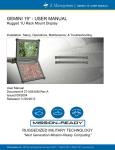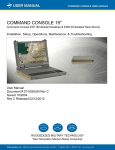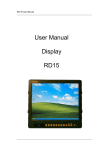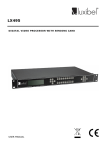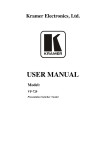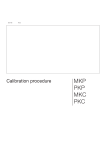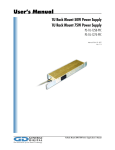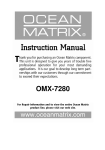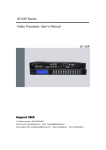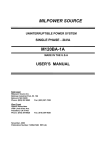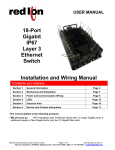Download VEGA DISPLAY USER MANUAL
Transcript
Z Microsystems | Vega Display User Manual VEGA DISPLAY USER MANUAL Rugged Display Platforms with Real-Time Enhanced Video Installation, Setup, Operations, Maintenance, & Troubleshooting User Manual 27-0048UM Revision A Released 11/27/2012 MISSION-READY RUGGED DEPLOYABLE COMPUTING Z Microsystems, Inc. · 9820 Summers Ridge Road, San Diego, CA 92121 · T: 858.831.7000 · F: 858.831.7001 · www.zmicro.com REGULATORY Z Microsystems | Vega Display User Manual REGULATORY INFORMATION WARNING TO PREVENT FIRE OR SHOCK HAZARDS, DO NOT EXPOSE THIS UNIT TO RAIN OR MOISTURE. ALSO, DO NOT USE THIS UNIT’S POLARIZED AC PLUG WITH AN EXTENSION CORD RECEPTACLE OR OTHER OUTLETS UNLESS ALL THREE PRONGS CAN BE FULLY INSERTED CAUTION RISK OF ELECTRIC SHOCK - DO NOT OPEN CAUTION: TO REDUCE THE RISK OF ELECTRIC SHOCK DO NOT REMOVE COVER (OR BACK OF UNIT). NO USER SERVICEABLE PARTS INSIDE. REFER SERVICING TO QUALIFIED PERSONNEL. This symbol warns the user that insulated voltage within the unit may have sufficient magnitude to cause electric shock. Therefore, it is dangerous to make any kind of contact with any part inside this unit. This symbol alerts the user that important literature concerning the operation and maintenance of this unit has been included. Therefore it should be read carefully in order to avoid any problems. 1. Use the power and video cables supplied with the product to help prevent interference with radio and television reception. adapters may cause interference with electronic equipment in the vicinity of this unit. The use of cables and 2. This equipment has been designed to meet severe conditions in military environments as specified in MIL-STD-810G, MIL-STD-461F and DO-160F. 3. This equipment is designed to meet the limits for Class A digital devices imposed by Part 15 of FCC rules. These limits are designed to provide reasonable protection against harmful interference when equipment is operating in commercial environments. This equipment generates, uses and can radiate radio frequency energy, and, if not installed and used in accordance with the instruction manual, may cause harmful interference to radio communications. 4. Operation of this equipment in a residential area is likely to cause interference in which case the user will be required to correct the interference at his own expense. Changes or modifications not expressly approved by Z Microsystems could void user’s authority to operate the equipment. ii TABLE OF CONTENTS Z Microsystems | Vega Display User Manual TABLE OF CONTENTS Section Page 1.0 Product Overview............................................................................................................................................................ 1 1.1 About This Manual.............................................................................................................................................. 1 1.2 Product Description............................................................................................................................................ 2 2.0 Installation & Setup.......................................................................................................................................................... 3 2.1 Installation.......................................................................................................................................................... 3 2.2 Fold-away Transport Handles............................................................................................................................. 4 2.3 Connections....................................................................................................................................................... 5 2.4 Touch Panel Setup............................................................................................................................................. 7 3.0 Operations....................................................................................................................................................................... 8 3.1 Push Button Controls......................................................................................................................................... 8 3.2 LED Indicators.................................................................................................................................................... 8 3.3 On-Screen Display Menus.................................................................................................................................. 9 3.3.1 Main Menu......................................................................................................................................... 9 3.3.2 Main Screen Picture Adjust................................................................................................................ 9 3.3.3 Main Screen Graphics Mode.............................................................................................................. 9 3.3.4 Main Screen Color Balance................................................................................................................ 9 3.3.5 Configurations Screen...................................................................................................................... 10 3.3.6 Advanced Options Screen............................................................................................................... 10 3.3.7 OSD Options................................................................................................................................... 10 3.3.8 Main Screen Information.................................................................................................................. 10 3.4 Picture in Picture (PIP) Menus........................................................................................................................... 11 3.4.1 PIP Main Menu................................................................................................................................ 11 4.0 Maintenance ................................................................................................................................................................. 13 5.0 Troubleshooting the Vega.............................................................................................................................................. 14 5.1 Troubleshooting Topics..................................................................................................................................... 14 5.2 Frequently Asked Questions............................................................................................................................. 16 6.0 Customer Support......................................................................................................................................................... 17 6.1 Contact Information.......................................................................................................................................... 17 6.2 Parts Replacement........................................................................................................................................... 18 7.0 Appendix....................................................................................................................................................................... 19 7.1 Vega 18.5” - Technical Information and Schematics.......................................................................................... 19 7.2 Vega 21.5” - Technical Information and Schematics.......................................................................................... 21 iii Z Microsystems | Vega Display User Manual 1.0 PRODUCT OVERVIEW This section will provide information and assistance with the following topics: • About This Manual SAFETY PRECAUTIONS • Product Overview DANGER: To avoid shock hazard: 1.1 ABOUT THIS MANUAL • Do not remove the covers around the Vega Display. This product manual provides information about the features, operation, installation, connections, troubleshooting, product replacement, limited warranty, and other important details about your new Z Microsystems product.. We recommend you read this manual carefully and follow the instructions in the installation chapter for verification of system functions and control settings. • Do not connect or disconnect the Vega Display during an electrical storm. This product manual and other resources are also available on the Z Microsystems website at www.zmicro.com. For further assistance please visit the Troubleshooting & Frequently Asked Questions section within this manual, or refer to the section dedicated to Customer Support. • The power cord plug must be connected to a properly wired and grounded power outlet. For added convenience and safety, you will find bookmarks and embedded visual cues for quick tips, warnings, new sections, and other safety related precautions. These are intended for quick supplemental reference and added ease in the installation and operations of the Vega Display. Please refer to the included Z Microsystems Vega Quick Start Guide for additional help with setup and operation of the Vega Display. Visual Notifications: WARNINGS AND SAFETY PRECAUTIONS NOTES AND PREPARATIONS Necessary Tools Necessary Hardware Additional assistance for the Vega Display Series, or other displays can be found on the Z Microsystem’s website along with highly customizable integration options for a wide range of platforms and applications. 1 Z Microsystems | Vega Display User Manual 1.2 PRODUCT DESCRIPTION The new Vega display series is engineered for rugged mobile performance. The Vega can be quipped with Z Micro’s latest third generation electronics; featuring Real-Time Enhanced Video (RTEV), a low-profile armored shell, and interactive touch screen functionality options. This display series deploys with a new ultra-high performance modular video processor; supporting all of your Picture-in-Picture (PIP) needs, as well as flexible viewing modes for Dual-View and Quad-View monitoring. The design goal for the Vega series was to deliver an unmatched operator experience with increased performance and ease in viewing multiple video feeds. Designed for 1080p viewing, this Wide Aspect Ratio display offers numerous view mode customizations and on-the-fly easy navigation display buttons. Rugged folding handles translate to convenient installation and transportation, without impeding operation, viewing angle, or consuming valuable space. Z Microsystems’ customers demand the very best in hostile and extreme conditions, which is why we are dedicated to equipping our Armed Forces and DoD customers with the pinnacle in ruggedized deployable computing and display solutions. The Vega display series is a culmination of engineering advances in our other best-selling displays; delivering the robust modularity and flexible viewing configurations of our veteran Orion UDP; along with the low-profile mobile advantages and RTEV functionality implemented in our Intelligent Display Series (IDS) panels. Highlights • • • • • • • • 18.5” & 21.5” active display area Native Pixel Resolutions up to 1920 x 1080 pixels for 21.5” 1366 x 768 pixels for 18.5” Supported scaled resolutions up to 1920x1200@60 for 18.5” and 21.5” Picture In Picture (PIP) Customization Digital, Analog, HDSDI, NTSC 2nd Channel available for PIP RS232 via USB Serial Interface MIL-5015 Rugged Power Connect • • • • • • • Real-time enhanced video imaging SoftMenu user-friendly on-screen GUIs Standard optically bonded AR shield Optional Infrared Touch Panel Rugged lightweight packaging Durable fold-away transportation handles Applications include shipboard, airborne, ground vehicles, & ground control stations 2 Z Microsystems | Vega Display User Manual 2.0 INSTALLATION & SETUP This section will provide information and assistance with the following topics: • Shipment Contents • Installation Walkthrough for 18.5” and 21.5” • Fold-away Transport Handles feature WARNING Using assembly hardware that does not match the provided specifications may damage internal components. • Connections & Cabling SETUP NOTES 2.1 INSTALLATION Shipment Contents Ensure the following parts are included in the package received from Z Microsystems. Verify all parts are in good condition and have not been damaged during shipment. If any of the parts are missing or damaged, immediately contact Z Microsystems’s Customer Service at 858-831-7040. For the fastest and easiest installation of the Vega Display Series, follow these instructions or the Installation Guide provided with your shipment. • Vega Display • Hardware Kit (Order specific) • Z Microsystems Product Folder (Includes: Shipping Information, Product DVD, User Manual, & other resources) • Power cable (MIL-5015 round locking connector) • Additional cables included (Order specific): • Video Cables: DVI-I, DVI-D, BNC • USB communication cable REQUIRED TOOLS SPECIFICATIONS #2 Philips screwdriver For installation of the Vega 21.5” 5/32” hex socket driver For installation of the Vega 18.5” Thread Locker (blue) For locking screws & nuts into rack (recommended) DISPLAY SIZE HARDWARE SPECIFICATIONS Vega 18.5” Hardware #10-32 Captive Hex Screws, 1.37” in length Clip Nuts OR #10-32 Nut w/ threadlocker (recommended) Vega 21.5” Hardware #10-32 Philips SEM Screw, 3/4” in length Clip Nuts OR #10-32 Nut w/ threadlocker (recommended) PREPARATIONS In preparation to setting up and installing the Vega Display, turn off the electrical power to computers and other electronic devices that will connect to the unit. INSTALLING THE VEGA 18.5” 1. Position the Vega display along the RETMA 19” mounting rack at the desired height. 2. Using a 5/32” hex socket ballpoint screwdriver, secure the Vega 18.5” display to the RETMA rack with (4) #10-32 captive hex screws. (as described in the table above) 3. Ensure that the Vega display is securely fastened to the rack at all four installation points. You have now successfully installed the Vega 18.5” display. 3 Z Microsystems | Vega Display User Manual INSTALLING THE VEGA 21.5” 1. Position the Vega display along the RETMA 19” mounting rack at the desired height. 2. Using a #2 Philips screwdriver, secure the Vega 21.5” display to the RETMA rack with (4) #10-32 SEM screws and paired clip nuts, locking nuts, or nuts with threadlocker using the Vega’s mounting leaf brackets. 3. Ensure that the Vega display is securely fastened at all four installation points. You have now successfuly installed the Vega 21.5” display. 2.2 FOLD-AWAY TRANSPORT HANDLES The Vega platform comes equipped standard with discrete and ruggedized fold-away transportation handles. These handles fold away and magnetically lock into place when the display has been installed and is being utilized in display mode. For convenient transportation of the unit, fold these durable handles out and carry with both hands. 4 Z Microsystems | Vega Display User Manual 2.3 CONNECTIONS Use the following diagrams and references to properly connect the Vega display for operation. Be sure to disconnect the all computers and other electronic devices from their power source before connecting the setting up the Vega display for operation. Connections Guide Label Connector Type J1: DVI-I 1 DVI-I Video Input (accepts DVI-D, w/o analog support) J2: DVI-I 2 DVI-I Video Input (accepts DVI-D, w/o analog support) J2*: PASS THROUGH BNC connection pass through for HDSDI signal J3*: INPUT BNC connector Video Input for HDSDI signal J7: USB HOST USB Type A-B for serial communications J8: TOUCH (SCREEN) USB Type A-B for touchscreen operation J9: POWER IN MIL-C-5015 round locking connector PREPARATIONS In preparation to connecting the Vega display, turn off the electrical power to computers and other electronic devices that will connect to the unit. ATTENTION The Vega Display will accept a standard DVI connector but will no longer support analog signals as offered by the onboard video controller. * Denotes DVI & HDSDI Configuration Reference Chart MIL-C-5015 Power Connector (See Note) DVI Connector (DVI-I & DVI-D Accepted) MIL-C-5015 NOTE AC MIL connector is illustrated in this reference chart to the left. MIL-C-5015 DC connectors can be recognized by a two-pin configuration. BNC Connector (HDSDI signal type) USB Type B Connector Dual DVI-I Configuration DUAL DVI-I CONFIGURATION: J8 Input on silkscreen may be labeled Touchscreen or USB. Regardless of silkscreen label, J8 input on this configuration is designed only for communication with the Infrared touch panel. DVI-I & HDSDI Configuration J8: TOUCH CONFIGURATIONS W/O TOUCH: Models without a touch screen utilize the J8 touch input as a pass-through USB access via the front of the Vega display. This USB input is located behind the folding transport handle, and can be easily concealed. 5 CONNECTIONS & SETUP Z Microsystems | Vega Display User Manual Connection Process SETUP TIP SIGNAL TYPE If the display is connected to power and video but does not recognize a video signal, the user will be notified with a message stating, “NO SYNC, PLEASE CHECK CABLE.” If you are experiencing trouble with the display not recognizing a video source you may need to change the “Channel Type” in the OSD Configuration menu. 1. Access the OSD Main Menu by pressing the “Menu” front panel button. For more information refer to section 3.2 describing LED Indicators. 2. Enter the “Configuration” menu. 3. Change the desired Channel Type to the appropriate incoming signal type. 1. Use the following steps and the silkscreen callouts on the rear panel of the display for the connections process. Warning - Configuration differences in Power (AC/DC), as well as video inputs (DVI-I/ HDSDI, etc.). 4. Connect HDSDI cable to J3 - Connect the locking BNC connector cable supplying your video source to J3: INPUT (HDSDI). 2. Connect a Power Source - Connect the MIL-C-5015 round locking connector to J9: Power. Note the notch configuration and pinmating when connecting to power to avoid damaging the unit. 3. Connect DVI cable to J1 - Connect the DVI-I cable supplying your video source from the host computer to J1: DVI-I. 5. Connect USB for Touch & Serial Connect USB Type B connector to the J8: TOUCH position for touch screen communications or the J7: USB HOST for serial host communications. 4. Verify Functionality - When the connection process has been completed, turn on Vega & devices to confirm functionality. LED channel indicators should turn green. Status indicator turns green when video signal is recognized. For additional video signal setup.. Additional setup may be required for Touch Screen Functionality. Instructions on Touch Panel Setup can be found in Section 2.4. For Troubleshooting assistance visit the Troubleshooting section of this manual. 6 Z Microsystems | Vega Display User Manual 2.4 INFRARED TOUCH PANEL The Vega display is engineered with an infrared touch panel for intuitive touch function operations. This infrared touch screen array can pick up the touch of a gloved finger, stylus, or pen. The latest infrared touch technology utilizes the HID (Human Interface Device) drivers that are built into most modern operating systems including: Windows 7, Mac OSX, and Linux. No driver is necessary for operation of the Infrared Touch Screen using these operating systems. Drivers for other products and resistive screens can be found using the following links: www.zmicro.com/downloads/drivers.html If the touch screen option has been purchased for the Vega, ongoing communication between the host computer and display via USB interface is required throughout operation. DRIVERS ON THE SITE Drivers for touch screen operation and other products can be found at www. zmicro.com via the following menu path: 1. Access the “Resources” submenu from the Header Menu. Operating the Touch Panel In order for touch functionality to work with this display, ensure that the USB communication cable is securely connected to the Vega display and your host computer. When this communication path has been verified, HID drivers that are standard to modern operating systems will be automatically installed. For more information and assistance with troubleshooting, please visit help resources for your respective operating system. Tap to Select - Tap once to select an application or file. (This is standard to most operating systems) TOUCHSCREEN NOTE Double-Tap to Enter - Double-tapping on an icon will activate/open the file or icon. 2. Select the “Downloads & Drivers” option. 3. Navigate to the desired product type. Press and Hold - Pressing and holding for a few seconds will behave as ‘right-clicking’ on the item, displaying an action list. Press and Drag - Pressing and dragging will allow the user to move the icon, file, or or object across the screen for the duration of the hold. 7 Z Microsystems | Vega Display User Manual 3.0 OPERATIONS SETUP This section will provide information and assistance with the following topics: The following procedures are written for setup using the buttons on the display panel. • Navigate through the PIP SoftMenus • Display Panel Control Functions • How to: Restore Factory Settings • Navigate through Z Micro OSD SoftMenus 3.1 PUSH BUTTON CONTROLS NOTE The Vega Display features push-button controls on the lower front bezel of the monitor. These buttons provide easy access to the On-Screen Display (OSD) and allow the user to navigate through menus and adjust image settings. The control buttons allow the user to control backlight operations, to store settings, and to revert to factory settings. For setup and operation of the Vega display, use the following controls to fine tune the image. Green LED (Channel 1) Input Select Green LED (Channel 2) User Programmable Function #2 User Programmable Function #1 + Menu/Select Status (Red/Green/Amber) Exit Standby - Button Functionality Description Table: Display Key Input Select Z1/Z2 Functions Menu/Select - + Exit Standby Function Toggles available channels. Corresponds with active LED. Customizable user programmable function. Contact Sales for more Information. Activates OSD. Activates/ Deactivates Selected Menu Item. (Changes are saved as they are modified) Navigates down to the next menu item. Decreases value of the Selected menu Item. Navigates up to the next menu item. Increases value of the activated menu item. Exits from On-Screen Display main menu or returns from submenu to main menu. Hold down to illuminate the backlight. (Power Saving Option) (Changes are saved as they are modified) Note: This is NOT a power switch. 3.2 LED INDICATORS Channel LEDs Status LED 1— Green — Video A is selected Green — power and signal 2— Green — Video B is selected Amber — power and no signal Off — Standby mode / no power 8 OPERATIONS Z Microsystems | Vega Display User Manual 3.3 ON-SCREEN DISPLAY MENUS 3.3.1 MAIN MENU MAIN MENU To access the On-Screen Display main menu, press the menu button on the front of the panel. All display functions are controlled using the Main Menu’s subtopics. PICTURE ADJUST GRAPHICS MODE These submenus can be accessed for adjustments and information via the display keys on the bottom panel of the display. Refer to the following sections for specific operations and utilities that are provided in each of the submenus. COLOR BALANCE CONFIGURATION INFORMATION ADVANCED OPTIONS PIP MENU 3.3.2 PICTURE ADJUST PICTURE ADJUST MAIN CH 1 MAIN BRIGHTNESS MAIN CONTRAST 0 100 0 100 To adjust the display brightness and contrast use the - and + buttons to highlight the “Picture Adjust” option. Press the “Menu” button to access the submenu. Navigate to the desired option using the - and + buttons. Use the Menu button to activate the option. (Background color of the slider will change when the option is selected.) Use the ^ and v buttons to increase or decrease the value. Press Menu button again to deactivate the option. This will save any changes. (NOTE: Contrast is not available for digital signal images and “Main Contrast” option will be grayed out and unavailable.) 3.3.3 GRAPHICS MODE To make adjustments to the display images positioning, width, or the video sampling clock use the - and + buttons to highlight the “Graphics Mode” submenu. Press the “Menu” button to access the “Graphics Mode” submenu. GRAPHICS MODE MAIN CH 1 HORIZ. COARSE HORIZ. FINE VERT. POSITION HORIZ. POSITION 0 100 0 100 0 100 0 100 The “Graphics Mode” menu is used to adjust the positioning of the image. Highlight the desired option using the ^ and v button. Use the Menu button to activate the option. (Background color of the slider will change.) Use the - and + buttons to increase and decrease the value of the selected option, respectively. Adjust the image to desired specifications and press menu again when finished to deactivate the option. The “Horz Coarse” option adjusts the horizontal width of the image. The “Horz Fine” option adjusts the phase of the video sampling clock. Press “Exit” to return to the Main Menu. The new adjustments will be applied automatically. (NOTE: The Horz Coarse and Horz Fine options are not applicable for digital channels). 3.3.4 COLOR BALANCE To adjust the color of the display use the ^ and v buttons to highlight the “Color Balance” submenu. Press the “Menu” button to access the “Color Balance” submenu. COLOR BALANCE MAIN CH 1 RED GREEN BLUE 0 100 0 100 0 100 Highlight the color balance submenu using the - and + buttons. Use the Menu button to activate the desired option. (Background color of the slider will change.) Use the ^ and v buttons to increase or decrease the value. Press menu again to deactivate the option. Press “Exit” to return to the Main Menu. The new adjustments will be applied automatically. (NOTE: Color Balance menu topics Red, Green, and Blue adjustments are available only for analog signal images. Menu topics will be unavailable and grayed out for digital signals) 9 OPERATIONS Z Microsystems | Vega Display User Manual 3.3.5 CONFIGURATION CONFIGURATION MAIN MENU TIMEOUT 0 100 fACTORY SETTINGS CHANNEL 1 T YPE: ANALOG CHANNEL 2 T YPE: ANALOG CHANNEL SELECT: CHANNEL 2 SCALE MODE: NORMAL Menu Timeout: This is the amount of time the menu will remain displayed before timing out and disappearing from the screen. Timeout varies from 4-5 seconds (at 0) up to roughly 4 minutes (at 99). At the 100 setting, the menu will not timeout. It will disappear only when toggled off by the operator. Reset Default Settings: Resets all Main Menu settings to the factory default settings. Channel Type: Channel Type sets the DVI-I Channel to accept either analog or digital input. Channel Select: The Gemini Display has two channel options. Highlight “Channel Select” and press Menu button to change channels. Scale Mode: There are three scale modes: NORMAL, SCALED ASPECT RATIO (SAR), and NO SCALE. NORMAL mode scales the source image to the full panel size and aspect ratio. SAR mode will keep the aspect ratio of the incoming signal and use the maximum image size possible for the source aspect ratio. NO SCALE mode uses the native source resolution and aspect ratio and displays the image without scaling. SAR and NO SCALE images are centered on the panel with black bars on the sides where no image is present. 3.3.6 ADVANCED OPTIONS ADVANCED OPTIONS MAIN These options are available for operation and the future development of Z Microsystems’ Real-Time Enhanced Video proprietary video enhancement technology. RTEV SETTINGS RTEV Settings: Only available on RTEV-embedded displays. Please contact your Z Micro Sales Rep for more information. RTEV GEOMETRY OSD OPTIONS RTEV Geometry: Only available on RTEV-embedded displays. Please contact your Z Micro Sales Rep for more information. 3.3.7 OSD OPTIONS OSD Options allows you to modify OSD menu settings to adjust the vertical and horizontal position as well as the transparency of the On-Screen Display. OSD OPTIONS MAIN VERT POSITION HORIZ POSITION 0 100 0 100 3.3.8 INFORMATION Vert Position: Vert Position allows the user to change the position of the OSD screen in vertical position (Y-axis). Horiz Position: Horiz Position allows the user to change the position of the OSD screen in horizontal position (X-axis). WARNING It is advised to contact Z Microsystems Customer Support if the temperature exceeds 65C. Use the - and + buttons to highlight the “Information” option. Press the “Menu” button to access the “Information” submenu. Within this submenu, the user can view firmware version, build date, incoming video signals, and display operating temperature. Temperature displayed is the onboard circuit-board temperature. Temperature variation is common and expected. 10 OPERATIONS Z Microsystems | Vega Display User Manual 3.4 PICTURE IN PICTURE (PIP) MENUS The following section describes operations and navigation of the OSD PIP Menus. PIP MAIN MENU The PIP main menu can be accessed through the OSD Main Menu using the same front panel control buttons throughout the OSD. Using the Control Panel buttons, select the PIP Menu. From this menu, there is one option: HD-SDI PIP menu. Use the directional buttons to select the proper menu and use the ‘menu’ button to activate/select the chosen menu. PIP MENU HD-SDI PIP PIP LIMITATIONS The second input, Channel 2, on each video input card has a PIP limitation of 1024 x 768 pixels. These submenus can be accessed for adjustments and information via the push button display controls on the bottom panel of the display. The following sections detail the adjustments and operations of PIP windows. NOTE - *For different products, the Video PIP submenu illustrated in the picture to the right may be labeled as DVI-I PIP or HD-SDI PIP, denoting the connection type for the specific model. PIP MENUS From the HD-SDI PIP Menu, the user can select and make adjustments to the PIP channel. PIP Select: No change is available for PIP Select. HD-SDI PIP MENU PIP # 2 PIP SELECT Geometry: This menu sets size and position of the PIP window, as well as image position within the window. 2 GEOMETRY Video Settings: This menu offers adjustment levels for contrast, brightness, color, and tint in the selected PIP channel. VIDEO SETTINGS CONFIGURATION INFORMATION Configuration: Use this menu to enable/disable PIP channel 2, restore factory settings, and turn chroma key use on and off. Information: This menu displays PIP firmware info and date, part number, and current resolution status. PIP GEOMETRY The HD-SDI PIP Geometry menu can be used to adjust the size and positioning of the PIP window and the picture displayed by the channel. GEOMETRY PIP # 2 PIP SIZE 0 85 100 0 100 100 0 0 100 0 25 50 0 25 50 PIP HORIZ POS PIP VERT POS IMAGE HORIZ POS IMAGE VERT POS PIP Size: This will increase/decrease the overal size of the PIP window while maintaining current aspect ratio. PIP Horiz Position: This option adjusts the horizontal (X-axis) location of the PIP window. PIP Vert Position: This option adjusts the vertical (Y-axis) location of the PIP window. Image Horiz Position: This option will adjust the horizontal (X-axis) location of the displayed image within the PIP. Image Vert Position: This option will adjust the vertical (Y-axis) location of the displayed image within the PIP window. 11 OPERATIONS Z Microsystems | Vega Display User Manual PIP VIDEO SETTINGS The HD-SDI PIP Video Settings menu is used to adjust contrast, brightness, color, and tint. Contrast: This option will adjust the balance of light and dark colors as well as light brightness of an image. VIDEO SETTINGS PIP # 2 CONTRAST 0 100 100 0 050 100 0 050 100 BRIGHTNESS COLOR TINT 0 000 50 Brightness: This ‘Brightness’ option adjusts the light intensity level of the display. Color: This option will adjust the SMPTE color balance of the image to achieve Tint: This option will adjust the horizontal (X-axis) location of the displayed image within the PIP window. PIP CONFIGURATION CONFIGURATION PIP # 2 PIP ENABLE: PIP Enable: This option will turn on and off the selected PIP channel. OFF FACTORY SETTINGS CHROMA KEY: The HD-SDI PIP Configuration menu allows the user to enable/disable the PIP channel, default this channel to factory settings, and turn on and off the chroma key functions. Factory Settings: This option will reset the PIP channel with default factory settings. OFF Chroma Key: This option toggles on and off the Chroma key functions, a built in color coded image overlaying process. PIP INFORMATION INFORMATION PIP # 2 Users can find current system firmware version and date information, as well as part number and visual queues for current resolution status in this PIP Information menu. Z MICROSYSTEMS INC. WWW.ZMICRO.COM FIRMWARE: ZDHC 50C2 02/12/12 PART NUMBER: 32-00104 RESOLUTION: INVALID NTSM-MJ 12 Z Microsystems | Vega Display User Manual 4.0 MAINTENANCE WARNING Cleaning the Monitor Unplug the monitor from the power outlet before cleaning. • The Vega Displays are constructed with either an optically bonded resistive touch screen or optically bonded Anti Reflective (AR) shield. When cleaning the screen surface, a clean, lint-free cloth must be used. Isopropyl alcohol or monitor glass cleaner may be used to clean finger prints or smudges on the monitor’s screen. First, apply the cleaning solution to the clean, lint-free cloth before wiping the monitor. Do not apply the cleaning solution directly to the monitor. WARNING Do not use water to clean the screen. Do not spray water or cleaning solution directly onto the display. Apply first to a lint-free cloth before wiping down the monitor. CAUTION Do not use benzene, thinner, ammonia or any volatile substances to clean the monitor screen or housing. These chemicals may damage the unit. Be sure to turn off the power before you perform any maintenance on the monitor. WARNING To avoid risk of electric shock, do not disassemble the monitor cabinet. Users cannot service the monitor. User maintenance is restricted to cleaning as explained below. 13 TROUBLESHOOTING Z Microsystems | Vega Display User Manual 5.0 TROUBLESHOOTING THE VEGA This section will provide information and assistance with the following topics: • Troubleshooting Topics for the Vega display • Frequently Asked Questions about the Vega display 5.1 TROUBLESHOOTING TOPICS No Main Display Image If the cable from the computer to the display is secure, determine the color of the Status LED and follow the appropriate procedure below. Black - Cause: If the status LED is black (unlit), the unit is on standby or is not receiving power. Recovery: • Press and hold standby button. • Ensure the power cable is plugged into the source. • Connect the power cable to a AC outlet. Ensure the AC outlet is active. • Turn on the display’s backlight by pressing the standby button. Amber - Cause: If the status LED is amber, there is power but no video signal is being received. Recovery: •If Video 1 or Video 2 is selected, ensure there is a video signal coming into the selected channel. •Ensure there is a video signal coming from the computer. •Be sure the channel type is set correctly for the video signal that is provided by the graphics card. Confirm that the display is setup to analog or digital and verify the outgoing signal from the host computer matches this signal type. Green - Cause: When the status LED is green, there is both power and a video signal. If there is still no image, follow these recovery steps: Recovery: • Ensure the video signal coming from the computer is not a black screen. • Ensure the Channel Type is selected corresponding to the incoming video signal. • Ensure the Channel Type under “Configuration” in the OSD menu corresponds to the signal type (i.e. ANALOG or DIGITAL). • Make sure the right cable is being used for the incoming video signal. DVI-D will not support an ANALOG signal. • Try a known supported video source resolution and frequency as listed in the Appendix for specifications. • If these Recovery criteria have been met and the issue is not resolved there is potentially a hardware failure. (Tech Support pg. 19) Display Image has Poor Color or Brightness (Analog Signal Issue) Possibe Recovery: Red, Green, and Blue gains can be adjusted from the Color Balance menu topic within the OSD Main Menu. Best quality color is generally achieved when red, green, and blue gains are balanced and all at similar levels. In the Picture Adjust submenu, ensure “Main Brightness” setting is at a sufficient level. Display Image Has Vertical Bars (Analog Signal Issue) Possibe Recovery: If the main image begins to display vertical bars, adjust the “Horz Coarse”. From the Main Menu, use the Up and Down buttons to highlight the “Graphics Mode” option. Select the “Graphics Mode” submenu and use the left and right arrow buttons to adjust the screen until the number of bars is reduced. Continue adjusting one step at a time until the bars are no longer visible. Make sure that the connectors are seated properly on the back of the Vega display. “Horz Coarse” option is only available for Analog video signals. 14 TROUBLESHOOTING Z Microsystems | Vega Display User Manual Display Image Has Horizontal Bars (Analog Signal Issue) Possible Recovery: If the main image begins to display horizontal bars, check that the video input cable is securely attached to the back of the monitor. If this does not resolve the issue there is a chance the connector cable is damaged or defective. Try replacing the DVI cable with a new one to see if the bars disappear. Display Image Appears Fuzzy / Poor Quality (Analog Signal Issue) Possible Recovery: If the main image begins to appear fuzzy or “noisy”, adjust the “Horz Fine” until it is reduced. The “Horz Fine” option adjusts the phase of the video sampling clock. To access the “Horz Fine” submenu from the Main Menu, use the up and down arrow buttons to highlight the “Graphics Mode” option. Press the “Menu” button to access the “Graphics Mode” submenu. The “Horz Fine” and “Horz Coarse” options are only availabe to ANALOG video sources. If the configuration screen reads ANALOG for the Channel Type and the user is expecting a DIGITAL signal, then the display may not be receiving a digital signal that it can understand. This problem may result from an incompatibility in the graphics card. The source graphics card may not be certified to full DVI-I specification and may be defaulting to an analog signal. One option is to change the configuration in the graphics card to transmit only a DVI-D signal. A second option is to use a DVI-D cable to connect the host system to the display. Possible Recovery: In some cases, poor image quality may be caused by a break in the connection. Check for potential breaks by looking for damage or frays to the cable, particularly near connector heads. Also check connector pins to ensure that they are properly aligned to fit into the designated connector jack. If the problem persists, try replacing the video cable. Possible Recovery: Some electronics and cellular devices generate electrical/radio interference. The problem may result from close proximity to such a device. Be sure that all items that may cause interference are kept away from the display. Possible Recovery: Low signal level is a potential cause for poor image quality. If the previous processes have not resolved the issue, try connecting the display to a video source that provides a clear picture to another display. This will rule out variables and narrow troubleshooting direction. Possible Recovery: Make sure that video cables are properly seated on the back of the display panel. A bad seating can have the RGB connectors misaligned. These RGB options are only available for Analog video signals. In the event that these color adjustments have been changed and are out of balance Reset menu settings to default. Display Image is Not Centered If the main image is not centered on the display, access the “Graphics Mode” menu in the OSD. Using the ‘+’ and ‘-’ buttons adjust the ‘Vert’ and ‘Horz’ position until image is appropriately centered. If the OSD is not positioned in a desired location, an independent menu for OSD options can be found within the “Advanced Options” menu. Problems with Analog Signal Resolution at 1920x1200x60 Possible Recovery: This issue is generally resolved by designating the correct signal format (digital or analog) under Channel Type in the Configurations OSD menu. This communicates to the display the correct Extended Display Identification Data (EDID) information. The settings are passed on to the Graphics Card and 1920x1200x60 reduced blankoing is produced by the graphics card. Be sure that the EDID information is passed to the graphics card and that your graphics card recognizes the Vega Display as a “ZMicro display.” 15 FREQUENTLY ASKED QUESTIONS Z Microsystems | Vega Display User Manual 5.2 FREQUENTLY ASKED QUESTIONS Question: Answer: • Why are certain Menu Options blocked out and unavailable? • Certain Menu Options are specific to DIGITAL or ANALOG signals. • Why does the transport handle snap when returning it to the operational position? • The Vega Display is equipped with magnets to hold the durable transport handles in place • How do I update my displays’s firmware? • Updating the firmware for a display can be sensitive. Before starting this process, please review the specific configuration for your display series. Also, updating your firmware will depend on your display’s interface. 16 CUSTOMER SUPPORT Z Microsystems | Vega Display User Manual 6.0 CUSTOMER SUPPORT 6.1 CONTACT INFORMATION Technical Support If you are unable to correct the problem yourself, contact Z Microsystems at: Phone: Fax: Website: Email: (858) 831-7040 (858) 831-7001 www.zmicro.com [email protected] NOTE For more help topics, late-breaking news, and information on the latest products and accessories from Z Micro, visit us at our website: www.zmicro.com Before calling, please have available as much of the following informationa s possible: 1. Model and serial number for the label on the monitor. 2. Purchase P.O. 3. Description of the problem 4. Computer type and model 5. System configuration (hardware fitted, etc.) 6. System BIOS version number 7. Operating System and version number 8. Display driver version number 9. Video Adapter Type CUSTOMER SERVICE If possible, stay by the computer. The Z Microsystems Technical Support Representative may wish to go through the problem with you over the phone. Documentation Assistance If you are unable to find documentation for your specific product, contact Z Microsystems at: Phone: Email: (858) 831-7039 [email protected] Customer Feedback We value feedback on our products, their performance, problems found, and welcome all suggestions. Please send to: Customer Service Z Microsystems 9820 Summers Ridge Road San Diego, CA 92121 (or) www.zmicro.com Customer Satisfaction It is our passion to provide our customers with “Legendary” Products & Services. Your satisfaction is our #1 prioirity. If you have experienced difficulty during any stage of your Z Microsystems product purchase or use, or would just like to make suggestions, please leave us feedback via our online Satisfaction Survey. Please take a moment to complete our Customer Satisfaction Survey at: http://zmicro.com/customersurvey.html 17 MAINTENANCE & REPLACEMENT Z Microsystems | Vega Display User Manual 6.2 PARTS REPLACEMENT If the Z Microsystems Technical Support Engineer determines that the product needs to be replaced, a Customer Service Representative will issue a Return Material Authorization (RMA) number. An RMA number is required to return a product to Z Microsystems, regardless of the reason for the return. The Z Microsystems Customer Service Department/RMA Request Form will ask the customer to provide the following information: • model number of the defective product • serial number of the defective product • firmware revision (as detailed in the “Information” section of the Main Menu • problem with the defective product • return “ship to” address • the name and address of the company department to which we will send the invoice (if product is out of warranty or is different from the “ship to” address. • phone number and e-mail address of contact • purchase order number (PO #) You will be given an RMA number and will be asked to send the product to: Z Microsystems ATTN.: (RMA#) It is very important to reference the RMA# 9820 Summers Ridge Road San Diego, CA 92121 Disclaimer Z Microsystems warrants that every product is free from defects in materials, workmanship, and conforms to Z Microsystems’ stringent specifications. Z Microsystems calculates the expiration of the warranty period from the date the product is shipped. This means that the ship date on your invoice is your product ship date unless Z Microsystems informs you otherwise. During the warranty period, Z Microsystems will provide warranty service under the type of warranty purchased for the product. Replacement parts will assume the remaining warranty of the parts they replace. If a product does not function as warranted during the warranty period, Z Microsystems will repair or replace the part (with a product that is at minimum, functionally equivalent) without charge. If the product is transferred to another user, the warranty service is available to that user for the remainder of the warranty period. Z Microsystems’ warranties are voided if the covered product is damaged due to an accident or abuse. The warranty is voided if the product is shipped with insufficient package protection. Under no circumstances is Z Microsystems liable for any of the following: 1. Third-party claims against you for losses or damages. 2. Loss of, or damage to, your records or data. 3. Economic consequential damages (including lost profits or savings) or incidental damages, even if Z Microsystems is informed. Some jurisdictions do not allow the exclusion or limitation of incidental or consequential damages, so the above limitation or exclusion may not apply to you. This warranty gives you specfic legal rights and you may also have other rights that vary from jurisdiction to jurisdiction. Warranty does not take effect until full payment is received by Z Microsystems. 18 APPENDIX Z Microsystems | Vega Display User Manual 7.0 APPENDIX 7.1 VEGA 18.5” - TECHNICAL INFORMATION & SCHEMATICS VEGA 18.5” - Technical & Environmental Specifications Environmental LCD Panel Active Display Size 18.5" Operating Temp 0°C to +50°C Native Pixels 1366 x 768 (1 Million Pixels) Non-Op Temp -40ºC to +70ºC Color Palette 16.7 Million Humidity 5% to 95% Non condensing (Design Goal) Brightness 300 cd/m2 Non-Op Altitude Up to 40,000 ft. Viewing Angle +/-85º Horizontal / +/- 80º Vertical Operating Altitude Up to 15,000 ft. Controls User accessible via Control Panel or SoftMenu Vibration DO-160 Section 8 Curve B TouchScreen, AR Shield, AG Shield Shock MIL- STD-810G, 30g’s MicroMesh* Fungus Non-Nutrients/Contaminants Options Reliability Power Power Consumption 44 W MTBF 50,000 hrs, Backlight and LCD only Power Supply AC: 100-240 VAC, 2.0A input @ 50-60Hz, 400Hz MTTR <30 Minutes DC: 18-36 VDC, 2.0A input @ 50-60Hz, 400Hz Regulatory Safety Input Connectors Display DVI-I with optional features including analog (HD-15), NTSC/PAL (BNC), digital (DVI-I), or HDSDI (BNC) Power Cable 6' cable, AC/DC Inlet Connector Standard Touch Screen Interface USB EMI/EMC IEC 60950 used as a guideline MIL-STD-461F, RE101 Army Limits, RE102 Shipboard Limits (Aircraft > 25m option), RS101, RS103 (20v/m 2MHz and 60v/m 1GHz18GHz), CE102, CS114, CS115, CS116 Quality/Workmanship IPC / ISO 9001:2008 and applicable section of MIL-HDBK-454 Physical Size 11.50” H x 18.31” W x 4.66” D Weight Approximately 15 lbs. *Information is subject to change without notice. Supported Resolutions 1920x1080x60Hz, 1920x1200x60Hz, 1440x900x60Hz, 1280x1024x60Hz, 1280x1024x67Hz, 1280x1024x75Hz, 1280x1024x85Hz, 1280x768x60Hz, 1280x768x75Hz, 1152x864x75Hz, 800x600x60Hz, 800x600x72Hz, 800x600x75Hz, 800x600x85Hz, 640x480x75Hz, 640x480x85Hz 19 15.90 1.38 Z Microsystems | Vega Display User Manual 12.48 3.19 7.875 C .38 16.415 Vega 18.5” - Schematics 7.875 C 16.415 18.652 4X 10-32 CAPTIVE SCREWS 2 REVISIONS 4X 10-32 CAPTIVE SCREWS REV 7.000 4 B 1 18.652 DESCRIPTION 3 DATE APVD 11.501 2 7.000 11.501 B APPROX 24LBS PREP REV D DESCRIPTIO VARIES BY CONFIGURATION 38 18.312 18.312 15.90 1.38 12.48 3.19 4.66 .38 A C VENT HOLES 4.66 7.875 16.415 A 1.462 4 2.88 3 VENT HOLES 1.462 VENT HOLES 2.88 18.652 APTIVE SCREWS 1 4 3 9.45 7.000 2 9.71 11.501 2 9.45 9.71 B .316 18.312 .91 .13 .316 .91 .13 20 Z Microsystems | Vega Display User Manual 7.2 VEGA 21.5” - TECHNICAL INFORMATION & SCHEMATICS Vega 21.5” - Technical & Environmental Specifications Environmental LCD Panel Active Display Size 21.5" Operating Temp 0°C to +50°C Native Pixels 1920 x 1080 (2 Million Pixels) Non-Op Temp -40ºC to +70ºC Color Palette 16.7 Million Humidity 5% to 95% Non condensing (Design Goal) Brightness 250 cd/m Non-Op Altitude Up to 40,000 ft. Viewing Angle +/-85º Horizontal / +/- 80º Vertical Operating Altitude Up to 15,000 ft. Controls User accessible via Control Panel or SoftMenu Vibration DO-160 Section 8 Curve B Options TouchScreen, AR Shield, AG Shield Shock MIL- STD-810G, 30g’s MicroMesh* Fungus Non-Nutrients/Contaminants 2 Reliability Power Power Consumption Power Supply 66 W MTBF 50,000 hrs, Backlight and LCD only AC: 100-240 VAC, 2.0A input @ 50-60Hz, 400Hz MTTR <30 Minutes DC: 18-36 VDC, 2.0A input @ 50-60Hz, 400Hz Regulatory Safety Input Connectors Display DVI-I with optional features including analog (HD-15), NTSC/PAL (BNC), digital (DVI-I), or HDSDI (BNC) Power Cable 6' cable, AC/DC Standard Supply Touch Screen Interface USB EMI/EMC IEC 60950 used as a guideline MIL-STD-461F, RE101 Army Limits, RE102 Shipboard (Aircraft > 25m option), RS101, RS103 (20v/m 2MHz and 60v/m 1GHz18GHz), CE102, CS114, CS115, CS116 Quality/Workmanship IPC / ISO 9001:2008 and applicable section of MIL-HDBK-454 Physical Size 13.00” H x 21.19” W x 4.81” D Weight Approximately 17 lbs. *Information is subject to change without notice. Supported Resolutions 1920x1080x60Hz, 1920x1200x60Hz, 1440x900x60Hz, 1280x1024x60Hz, 1280x1024x67Hz, 1280x1024x75Hz, 1280x1024x85Hz, 1280x768x60Hz, 1280x768x75Hz, 1152x864x75Hz, 800x600x60Hz, 800x600x72Hz, 800x600x75Hz, 800x600x85Hz, 640x480x75Hz, 640x480x85Hz 21 Z Microsystems | Vega Display User Manual 16.44 2.38 7.875 C 3.53 12.48 21.188 Vega 21.5” - Schematics .38 4X 1.403 7.875 C .196 3.09 21.188 1.403 4X 2 13.96 4 1 REVISIONS REV B .196 13.500 13.000 DESCRIPTION 3 2 DATE PREP APVD 2 13.96 13.000 NOTES: 1. WEIGHT: APPROX 24LBS 13.500 B REV 2 D DESCRI 2. I/O PANEL VARIES BY CONFIGURATION .316 18.312 38 16.44 2.38 12.48 3.53 .38 A 13.000 4.81 USB PASSTHROUGH 4.81 A VENT HOLES 7.875 21.188 1.403 4 3.09 4X .196 4 13.500 VENT HOLES C 3.09 VE 3 13.000 10.93 2 USB PA 3 VENT HOLES 1.403 13.96 2 .316 18.312 10.93 11.19 11.19 B .316 18.312 .316 4.81 .91 .91 .13 .13 UNLESS OTHERWISE SPECIFIED DIMENSIONS ARE IN INCHES TOLERANCES ARE: DECIMALS XX = .02 FRACTIONS 1/32 ANGLES 63 1 22 THIS DOCUMENT IS THE PROPERTY OF Z MICROSYSTEMS, INC. AND CONTAINS INFORMATION WHICH IS PROPRIETARY T Z MICROSYSTEMS, INC. NO PART OF THIS DOCUMENT MAY BE COPIED, REPRODUCE OR DISCLOSED TO THIRD PARTIES WITHOUT PRIOR WRITTEN CONSENT OF Z Microsystems | Vega Display User Manual Z Microsystems, Inc. 9820 Summers Ridge Road San Diego, CA 92121 Phone: (858) 831-7000 Fax: (858) 831-7001 Website: www.zmicro.com Copyright 2012 Z Microsystems, Inc. All Rights Reserved Z Microsystems, Inc. · 9820 Summers Ridge Road, San Diego, CA 92121 · T: 858.831.7000 · F: 858.831.7001 · www.zmicro.com


























